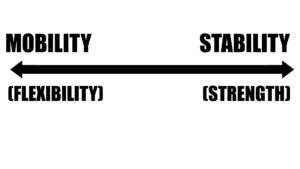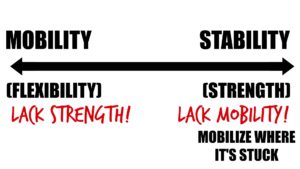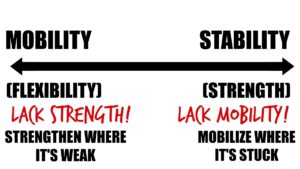Six of the best stretches and exercises to decrease pain and tension in your upper back. Thoracic self-mobilization techniques and strength training exercises to help eliminate your back pain and help you feel better. Tips and advice from a doctor of physical therapy.

WHAT CAUSES UPPER BACK PAIN?
There are many potential sources of upper back pain. In my professional experience, the three most-common causes of thoracic spine are joint inflammation, rib dysfunction, and muscle strain/knots. Again – there are many more potential causes than this, but these are the three that I encounter the most often in my physical therapy clinic. Fortunately, there’s a lot that the right stretches and strengthening exercises can do to alleviate your pain and symptoms in this area.
DOES POOR POSTURE CAUSE UPPER BACK PAIN?
Absolutely! In fact I would say postural issues are the #1 cause behind the majority of the back and neck pain issues that I treat in my clinic. In normal posture, your head sits squarely on top of your shoulders. Gravity keeps it there with very minimal effort required from your muscles. However – as soon as your head starts to come forward and your shoulders round forward (poor posture), now your muscles have to be active in order to keep your head from flopping straight down.
It’s this constant muscle activation from muscles that normally aren’t supposed to be active that causes fatigue, muscle tightness, and even pain in your neck and shoulders.
If you’re interested in learning more about your posture and what you can do to correct it, CLICK THIS LINK TO GET STARTED.
STABILITY VS MOBILITY
When we are talking about joints of the body (and especially joints of the spine) there’s one key idea that often governs rehabilitation: Stability vs Mobility. Your spine is a column of vertebrae stacked one on top of the other – it needs to be a stable structure to support your body. However, that column is also designed to bend and rotate (providing us movement) and therefore needs to be a mobile structure, as well.

The key to helping alleviate pain in this area in your upper back is often found in discovering the right balance for your body between stability and mobility. If you find your back is very stiff and doesn’t move very well (too much stability and not enough mobility) then your best treatment options should include stretching, foam rolling, and other joint mobilization techniques.

If, on the other hand, your back is very loose, flexible, and mobile, then you will most likely benefit from exercises focusing on stability (a.k.a. strength) versus stretching. A strong muscle is a tight muscle – the stronger your muscles in a given area the better the stability of that area.

WHAT ARE THE BEST EXERCISES TO ALLEVIATE PAIN IN MY UPPER BACK?
In the following video, I will share with you six of my favorite exercises for thoracic spine pain. These are the same exercises I give my physical therapy patients as homework to help mobilize their tight spines and then strengthen the areas that are weak. Hit PLAY on the video below and start to feel better today!
BEST STRETCHES AND MOBILIZATIONS FOR THORACIC SPINE PAIN (please see video for full demonstration of each)
- Thoracic Spine Rotation Stretch
- Lay on your right side. Bring both knees up as high as you can.
- Place your right hand on your left knee and your left hand on your left ribs.
- Rotate your left shoulder backwards towards the floor until a stretch is felt.
- Hold 20 seconds and return to starting position. Repeat three times.
- Chair Extension Mobilization
- Sit in a sturdy chair with firm support and a hard back.
- Link your hands behind your head and lean back up and over the back of the chair.
- Hold 3-5 seconds and then move up/down with your spine and repeat.
- Foam Roller
- Lay on a foam roller perpendicular to your spine.
- Link your hands behind your head and “roll” up and down on the foam roller.
- Proper form is key to making this one work! Watch the video to see how it’s done properly.
BEST STRENGTHENING EXERCISES FOR YOUR UPPER BACK
- Band Rows (bilateral and unilateral)
- Stand upright and grab the handles for resistance bands or cables (gym).
- Keep your core tight as you pull the handles into your armpits; focus on squeezing your shoulder blades together.
- Return slowly to the starting position; complete 3 sets of 10 reps.
- Wall Angels
- Stand with your back up against a wall. Your buttocks, shoulder blades, and back of your head should be in contact with the wall.
- Bring your arms up and place your knuckles against the wall.
- Slide your hands up over your head and then back down, keeping your knuckles in contact with the wall the whole time.
- Repeat 10 repetitions, 3 sets
- Prone W’s
- Lay on your stomach with your arms stretched out over your head.
- Lift your chest up off the floor while pulling your elbows down and behind you (“tuck your elbows into your back pockets”).
- Hold 2 seconds and slowly return to the starting position.
- Repeat 10 repetitions, 3 sets.
Upper back pain is a common problem for a lot of people, but it absolutely doesn’t have to be! Being in tune with your body and understanding the principles provided in this video (stretch where it’s tight; strengthen where it’s weak) are key to alleviating your pain and helping you to feel better.
Looking for more great tips and advice to help you feel better and alleviate pain in your back or neck? Here are some of my favorite videos to alleviate your back and neck pain:
HOW TO ELIMINATE MUSCLE KNOTS IN YOUR NECK AND SHOULDERS
BEST EXERCISES FOR NECK STIFFNESS
HOW TO SLEEP WITH NECK AND BACK PAIN
Make it happen,
Jared
